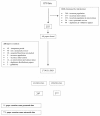Gaps in the evidence for prevention and treatment of maternal anaemia: a review of systematic reviews
- PMID: 22727258
- PMCID: PMC3475131
- DOI: 10.1186/1471-2393-12-56
Gaps in the evidence for prevention and treatment of maternal anaemia: a review of systematic reviews
Abstract
Background: Anaemia, in particular due to iron deficiency, is common in pregnancy with associated negative outcomes for mother and infant. However, there is evidence of significant variation in management. The objectives of this review of systematic reviews were to analyse and summarise the evidence base, identify gaps in the evidence and develop a research agenda for this important component of maternity care.
Methods: Multiple databases were searched, including MEDLINE, EMBASE and The Cochrane Library. All systematic reviews relating to interventions to prevent and treat anaemia in the antenatal and postnatal period were eligible. Two reviewers independently assessed data inclusion, extraction and quality of methodology.
Results: 27 reviews were included, all reporting on the prevention and treatment of anaemia in the antenatal (n = 24) and postnatal periods (n = 3). Using AMSTAR as the assessment tool for methodological quality, only 12 of the 27 were rated as high quality reviews. The greatest number of reviews covered antenatal nutritional supplementation for the prevention of anaemia (n = 19). Iron supplementation was the most extensively researched, but with ongoing uncertainty about optimal dose and regimen. Few identified reviews addressed anaemia management post-partum or correlations between laboratory and clinical outcomes, and no reviews reported on clinical symptoms of anaemia.
Conclusions: The review highlights evidence gaps including the management of anaemia in the postnatal period, screening for anaemia, and optimal interventions for treatment. Research priorities include developing standardised approaches to reporting of laboratory outcomes, and information on clinical outcomes relevant to the experiences of pregnant women.
Figures
References
-
- McLean E, Egli I, Cogswell M, De Benoist B, Wojdyla D. Worldwide prevalence of anaemia in preschool age children, pregnant women and non-pregnant women of reproductive age. Nutr Anaemia. 2007;1:1–12.
-
- Williams M, Wheby M. Anaemia in pregnancy. Med Clin North Am. 1992;76:631–647. - PubMed
-
- Lone F, Qureshi R, Emmanuel F. Maternal anaemia and it’s impact on perinatal outcome in a tertiary care hospital in Pakistan. East Mediterr Health J. 2004;10(6):801–807. - PubMed
-
- Letsky E. Maternal anaemia in pregnancy, iron and pregnancy – a haematologists viewpoint. Fetal Matern Med Rev. 2001;12(3):159–175.
Publication types
MeSH terms
Substances
LinkOut - more resources
Full Text Sources
Medical


